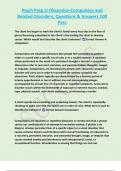Psych Prep U Obsessive-Compulsive and
Related Disorders; Questions & Answers 100
Pass
The client has begun to wash the client's hands every hour due to the fear of
germs becoming embedded in the client's skin leading the client to develop
cancer. Which would best describe the client's behavior? Correct Answer-A
compulsion
Compulsions are ritualistic behaviors that people feel compelled to perform
either in accord with a specific set of rules or in a routine manner. A repeated
action performed as the result of a persistent thought is termed a compulsion.
Obsessions refer to recurrent, intrusive, and persistent ideas, thoughts, images,
or impulses. Compulsions are the behaviors people with obsessive-compulsive
disorder will carry out in order to neutralize the anxiety caused by the
obsessions. Panic attacks typically are characterized by a discrete period of
intense apprehension or terror without any real accompanying danger,
accompanied by at least four of 13 somatic or cognitive symptoms. Acute stress
disorder occurs within the first month of exposure to extreme trauma: combat,
rape, physical assault, near-death experience, or witnessing a murder.
A client spends hours stacking and unstacking towels. The client is repeatedly
checking to make sure that the towels are in order of color. What term is used to
identify this behavior? Correct Answer-Compulsion
Compulsions are ritualistic or repetitive behaviors or mental acts that a person
carries out continuously in an attempt to neutralize anxiety. A phobia is an
illogical, intense, persistent fear of a specific object or a social situation that
causes extreme distress and interferes with normal functioning. An obsession is
a recurrent, persistent, intrusive, and unwanted thought, image, or impulse that
causes marked anxiety and interference with interpersonal, social, or
occupational function. Derealization is sensing that things are not real.
, Psych Prep U Obsessive-Compulsive and
Related Disorders; Questions & Answers 100
Pass
A client has a diagnosis of obsessive-compulsive disorder. The symptoms of the
disorder have seriously interfered with the client's ability to work. In order to
effectively work with the client, the nurse must understand that a compulsion is
what? Correct Answer-A repetitive, intrusive, and unwanted urge to perform
or performance of an act contrary to one's usual standards
A compulsion is an urge to perform a behavior or the actual performance of the
behavior (such as washing the hands), while an obsession is an intrusive thought
that recurs, even when unwanted. Depersonalization is a feeling of unreality or
strangeness concerning self, environment, or both. Obsessions are insistent
thoughts, recognized as arising from the self, which cannot be controlled.
Delusions encompass fixed false beliefs not true and not ordinarily accepted by
other members of the person's culture.
Which is the most common obsession experienced by a client diagnosed with
obsessive-compulsive disorder? Correct Answer-Fear of contamination
The most common obsession is fear of contamination and results in compulsive
hand washing. Fear of contamination usually focuses on dirt or germs, but other
materials may be feared as well, such as toxic chemicals, poison, radiation, and
heavy metals
What kind of behavior does the nurse anticipate observing when treating a
client obsessed with blasphemous thoughts? Correct Answer-Praying
repeatedly.
, Psych Prep U Obsessive-Compulsive and
Related Disorders; Questions & Answers 100
Pass
The client obsessed with blasphemous thoughts is compelled to pray or chant.
The client obsessed with order vacuums the rug in a particular direction. The
client worried about infection or cleanliness washes and scrubs until the skin is
raw. Some clients have an obsession for counting; they count each step taken,
tiles, and other objects in the surroundings.
The nurse is caring for a client undergoing cognitive behavior therapy for
obsessive-compulsive disorder. How does the cognitive model describe the
client's thought process? Select all that apply. Correct Answer-The client
wants to control own thoughts.
The client has intolerance for uncertainty.
The client overestimates the threats caused by the thoughts.
According to the cognitive model, the person believes that "if I think, it will
happen." Therefore, the client wants to control the client's own thoughts. This
client tries to be perfect and has intolerance for uncertainty. The client feels
threatened by the thoughts. All this causes an increased anxiety in the client
leading to some compulsive ritualistic behavior. As per the cognitive model, the
client's thoughts are influenced by an inflated sense of responsibility. This may
be a result of strict moral or religious upbringing.
The nurse is educating the client's family about compulsive behavior. The nurse
is correct when making which statement? Correct Answer-The behavior
neutralizes anxiety caused by obsessive thoughts.
, Psych Prep U Obsessive-Compulsive and
Related Disorders; Questions & Answers 100
Pass
The client attempts to suppress or ignore the intrusive thoughts by indulging in
ritualistic behavior. This behavior neutralizes the anxiety caused by obsessive
thoughts. However, the thoughts and behaviors are not realistically connected.
The client becomes agitated and anxiety levels increase when prompted to stop
by external stimuli. The client has normal intellectual functioning and is not on
the verge of insanity.
A nurse is planning care for a client who has been diagnosed with
trichotillomania. Which outcome should the nurse include in the client's plan of
care? Correct Answer-Client will demonstrate healthy coping strategies for
dealing with stressors
While the etiology of trichotillomania is not fully understood, the problem is
known to benefit from enhanced coping skills. Trichotillomania involves hair
pulling, not skin picking. Relationships are vital to support and recovery, but
healthy coping is even more important. It is beneficial for the client to
understand the disease, but it is more important to develop coping skills
Which client is most likely to be diagnosed with body dysmorphic disorder
(BDD)? Correct Answer-A client who firmly believes that everyone who sees
the client fixates on the size of the client's ears.
BDD is characterized by a disproportionate focus on a minor physical
characteristic. Clients with BDD do not necessarily binge and purge or engage in
dangerous weight loss. Underestimation of obesity is not typical of BDD.




